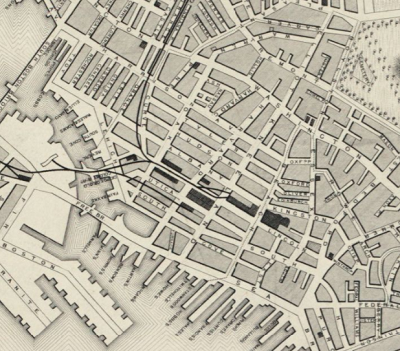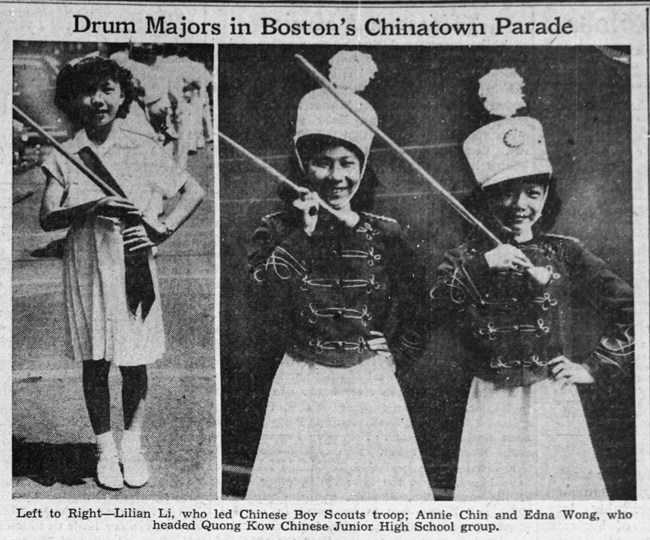Last updated: December 22, 2021
Article
An Early History of Boston's Chinatown
The first Chinese immigrants to settle in New England came in the mid-19th century as merchants and laborers with the intention of earning enough money to return to China and improve the economic situation of themselves and their families. The passing of the Chinese Exclusion Act in 1882 made it illegal for skilled and unskilled Chinese laborers to enter the country for over 60 years, having profound effects on the size of the Chinese American population and its gender profile. Through perseverance, Chinese immigrants and Chinese Americans established a community in Boston that provided services and a sense of home. Despite the severe restrictions of the Chinese Exclusion Act, the composition of Chinatown’s population began to change as immigrants found ways to evade these harsh laws. Later changes in immigration laws and the growth in community activities helped shape the Chinatown seen in Boston today.
Chinese Immigration in Boston
In 1870, Sampson’s Shoe Factory in North Adams, Massachusetts recruited 75 Chinese laborers from California to work as strike breakers. Seeing that these laborers worked for lower wages and produced higher outputs than previous workers, Sampson hired an additional 50 Chinese laborers from California. After three years, the Chinese laborers likely returned to California or China. However, due to a rise in riots against Chinese laborers in California, scholars suggest that some made their way to Boston.[1]

Leventhal Map Center, Boston Public Library
The Chinese settled in the South Cove, a section of the city between Downtown and the South End. Built on a landfill for the railroads and row houses, made land in the central Boston area was usually associated with low rents and low land values.[2] Many immigrants, including Irish, Jewish, Italian, and Syrian workers, also established enclaves in this area following the opening of the nearby South Station railroad hub.[3] Similar to many other nineteenth-century Chinatowns in the United States, Boston’s Chinatown was almost entirely composed of men, often referred to as a “bachelor society.” Many Chinese male immigrants came to the United States as sojourners, with the intention of earning enough money to return home and improve the economic situation of themselves and their families.[4] These men often worked hard and lived lonely lives, and the establishment of a community base helped provide them with services and a sense of home. Stores sold groceries and supplies, restaurants served familiar food, barbers cut and trimmed queues, and village associations distributed letters from home. For entertainment and escape, tongs ran gambling joints and opium dens.[5]
Anti-Immigration Backlash
Due to growing hostility, Chinese laborers experienced much exclusion from manufacturing and construction jobs. As a result, many Chinese turned to opening laundries along major streetcar and rail lines in Massachusetts and New England. Laundry work is noted to have required little capital investment, no proficiency in English, and a market virtually untouched by non-Chinese.[6]
In 1878, Denis Kearney, founder of the Workingman's Party in California, gave a speech to a full Faneuil Hall audience on August 4. He spoke strongly against Chinese laborers and described the workingmen of California as “becoming the oppressed. The capitalistic thieves and land robbers of California, instead of employing the poor men of their beautiful golden city, sent across to Asia, the oldest despotism on earth, and there contracted with a band of leprous Chinese pirates.”[7] In response to the nativism echoed in Kearney’s speech, the United States Congress passed the Chinese Exclusion Act in 1882. This made it illegal for both skilled and unskilled Chinese laborers to enter the country and for ten years banned the naturalization of Chinese people already in the country. Only merchants and a few other exempted categories of Chinese were permitted to enter and reenter the United States. Not repealed until 1943, the Exclusion Act had profound effects on both the size of the Chinese American population and its gender profile.[8]
Exclusion Acts both prevented immigrants from coming to the United States, while also granting limited rights to those already living in the country. One of the exclusion laws of 1894 read: “Chinese laborers or Chinese of any other class either permanently or temporarily residing in the United States shall have for the protection of their persons and property all rights that are given by laws of the United States to citizens of the most favored nation, except the right to become naturalized citizens.”[9] However, this did not stop authorities from attempting to drive Chinese residents out of Boston.

"Chinese Raid Denounced," Boston Evening Transcript, October 16, 1903.
On October 11, 1903, police used the presence of hundreds who had come in attendance of a funeral in Chinatown as an opportunity to stage a raid. Funeral ceremonies provided opportunistic circumstances for police to conduct a sweep, as large crowds of community members gathered to witness and participate in the rituals and burials. A force of about fifty local police and over twenty federal and state authorities conducted the raid.[10] Hundreds of laundrymen from the Boston region were rounded up and held if they could not produce the proper papers. In all, authorities arrested 234 men, deporting 52 of them.[11]
A few days later, Bostonians held an indignation meeting at Faneuil Hall to protest the raid. Attendees included professional bondsmen, lawyers, and Sunday school teachers, all of who showed up in support of the Chinese men who had their rights violated.[12] Many expressed their anger towards the authorities, and concern over this happening again. Boston attorney Hon. Winslow Warren, who attended the meeting, declared: ”To minimize the cruel raid on Chinatown is to be blind to the signs of the times and indifferent to individual liberty.”[13]
Building a Community
In 1906, an earthquake in San Francisco destroyed the regions birth records, aiding Chinese residents in gaining citizenship by claiming that they had been born in the United States. With their status assured, many Chinese men were able to travel to China to get married and have children who also gained citizenship status and were entitled to emigrate to the United States. This resulted in a slow but steady increase in the number of families in Boston’s Chinatown.[14]

"Drum Majors in Boston's Chinatown Parade," The Boston Globe, 1939.
With the rise of families, the community began to organize activities to serve the increasing number of children. Founded in 1892, the Denison Settlement House provided many services to immigrant women in the South Cove.[15] It additionally sponsored many activities, including a girls basketball team.[16] The Chinese Merchant Association founded the Kwong Kow Language School in 1916 to establish an educational institution to help maintain Chinese heritage among overseas Chinese. The school sponsored a marching band that participated in parades on holidays, opening Chinatown to the larger community.[17] Still in existence, it has since provided Chinese language and cultural education, academic support, and recreational programs for more than 20,000 children of Chinese immigrants in the Boston/Greater Boston area.[18]
Boston’s Chinatown continues to provide a sense of comfort and familiarity for new immigrants, and the growing generations of Asian Americans in the United States. Its strong sense of community allows it to be a place that is constantly evolving, and meet the needs of its current residents.
Contributed by: Catherine Van Even, Student Conservation Association Historic Preservation Intern
Footnotes:
[1] Neil Larson and Kathryn Grover, “Historic Resources Associated with Chinese Immigrants and Chinese Americans in the City of Boston,” Larson Fisher Associates, Inc, (2016) 11.
[2] Tunney Lee, Chinatown Atlas, Accessed July 12, 2021. https://www.chinatownatlas.org/era/bachelor-exclusion-era-1875-wwi/; Rhoads Murphey, "Boston's Chinatown," Economic Geography 28, no. 3 (1952): 244-55. Accessed July 15, 2021.
[3] Wing-kai To, Chinese in Boston, (South Carolina: Arcadia Publishing, 2008) 7.
[4] Larson and Grover, “Historic Resources Associated with Chinese Immigrants and Chinese Americans in the City of Boston,” 18.
[5] Lee, Chinatown Atlas.
[6] Larson and Grover, 14.
[7] ”Kearney,” The Boston Globe, August 5, 1878.
[8] Larson and Grover, 19.
[9] "An International Affair," Boston Evening Transcript, October 13, 1903.
[10] Peter Nien‐chu Kiang, "Asian American Studies Praxis and the Educational Power of Boston’s Public Chinese Burial Grounds," Chinese America: History and Perspectives (San Fransico, 2016) 59.
[11] Lee, Chinatown Atlas.
[12] "Will Meet To Protest," Boston Evening Transcript, October 14, 1903.
[13] "Chinese Raid Denounced," Boston Evening Transcript, October 16, 1903.
[14] Lee, Chinatown Atlas.
[15] "The New Denison House," Boston Evening Transcript, November 5, 1910.
[16] Wing-kai To, Chinese in Boston, 81.
[17] Lee, Chinatown Atlas.
[18] “History and Overview,” Kwong Kow School, Accessed July 2021, https://www.kwongkowschool.org/about/history/.
Tags
- boston national historical park
- chinatown
- boston
- faneuil hall
- immigration
- chinese american
- chinese american history
- chinese immigrants
- chinese immigration
- immigration history
- migration and immigration
- women and migration
- aapi history
- asian american and pacific islander heritage
- asian american and pacific islander history
- aapi
- massachusetts
